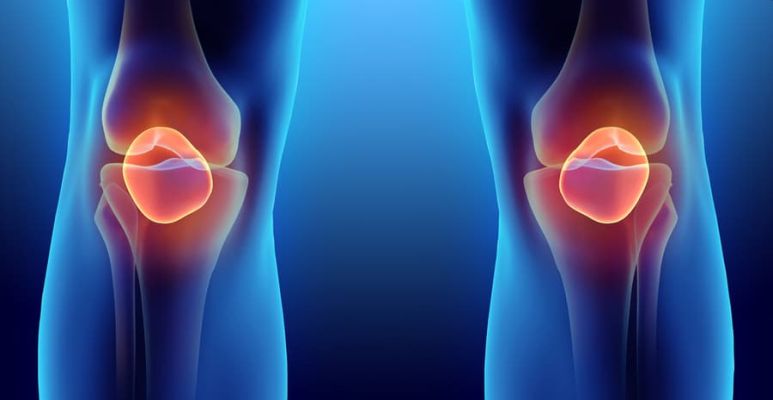Overview
In order to better understand what dislocation refers to at one knee or even at both knees, we need to know some information about the anatomical structure of the knee.
The patella is most often prone to dislocation because it is part of the knee joint and has the role of facilitating the connections between the thigh muscles and those of the tibia.
Due to its up-down movement when we flex and extend the leg at the time of trauma, the patella slides out of the patellar capsule.
Another lesser-known name for the patella is the kneecap, being a small sesamoid bone with a round shape, but flattened anterior-posteriorly with the anterior face in a triangular shape, which can palpate under the skin, thus forming the anterior knee relief.
This time of dislocation is more frequent in women, but also in men, especially young people, around the age of 20 years.
Dislocation can occur either as a result of a minor trauma or accidentally due to a wrong movement during a sport or other contexts.
Dislocation of the knee should not be confused with the sprain of the knee. The dislocation also involves affecting the other parts of the knee joint, while the sprain, being a milder condition, produces only a strain of the ligaments or even their rupture in extreme cases, but without the bones coming out of the joint.
And the pain is different in the two situations. In the case of knee dislocation, the pain is very intense and mobilization with foot support is impossible, while in the case of a knee sprain, the pain is bearable, and mobilization can be achieved.
Causes
The causes that lead to dislocation of the patella are given by:
- trauma to the knee;
- falls from the height;
- sports accidents after which the knee can be twisted;
- femoral-patellar dysplasia;
- patellar chondropathy;
- malposition of the patella given by the lateral insertion of the patella tendon;
- genus valgum (the shape of the legs in X);
- positioning the patella at a higher level, which can be a congenital cause;
- violent contact with another adversary by abruptly hitting the knee.
It should be mentioned that when the dislocation of the patella occurs accidentally, the situation can be a serious one because blood vessels, nerves can be damaged, there is the possibility of meniscus rupture or even the joint capsule may suffer.
If we talk about the event that the disruption occurs in athletes either by hitting the opponents or by falling to the knee, the consequences are less severe and, most of the time, do not accompany additional injuries.
Signs and symptoms
- the primary sign is the vivid and deafening pain accompanied by the characteristic "cracking" (cracking) noise;
- followed by rapid swelling of the area;
- deformation of the affected region;
- the impossibility of mobilizing the lower limb.
The diagnosis is most often made during the clinical examination when the orthopaedic in Delhi observes the signs and symptoms mentioned above. To see the exact location of the patella, it can perform an x-ray.
Another paraclinical examination recommended in special cases is the MRI, in order to detect possible ligament ruptures, cartilage or synovial membrane damage, components that cannot be visualized on plain radiography.
In the event that the patella replenishment occurs spontaneously either by yourself or by another person until you reach the orthopaedic in Dwarka, you should not overload the joint or force it or even delay the visit of orthopaedic in West Delhi because there may be small neurovascular lesions that may accentuate in the following hours or days.
It should also be mentioned that a timely treatment is 80% likely to have a solid and stable joint in the future, while lack or delay of treatment for various reasons reduces the chances of success by 20% and increase the risk of gonarthrosis.
Treatment
The initiation of orthopedic treatment is mainly based on pain relief and prevention of complications.
The orthopedic reduction translated by repositioning the joint is intentional besides the relief of pain. This repositioning will be performed under general anesthesia, in case of surgery.
Another relatively modern surgical treatment is the arthroscopic one, with numerous advantages for the patient, starting from the reduced incisions in size and to the shorter recovery time.
Arthroscopy in Delhi can reconstruct some injured ligaments during dislocation and reduce joint stiffness.
Infiltration treatment is renowned for the benefits of platelet-enriched plasma. This plasma will be introduced at the level of the affected knee, in order to recover rapidly from the collateral lesions.
We must not omit the immobilization of the knee, which is done by putting the plaster (gypsum) of the knee for a period of 3 weeks to 2 months.
Kinetotherapy also plays an essential role in the recovery of patients after a knee dislocation.
The recovery program is established in collaboration with the kinetotherapist and the orthopaedic surgeon in Delhi, depending on the treatment applied and can be extended for up to 1 year.
Depending on the evolution of the patient, the degree of difficulty of the exercises can be intensified, but with the limitation of the flexion and extension movements of the knee in order not to overload the joint.
Physiotherapy in Delhi is also recommended, which aims to reduce local inflammation of the affected knee.
Prevention
There are no special measures to be taken because, for the most part, accidents are not scheduled and can happen anytime, anywhere.
However, going to the gym or playing sports helps strengthen the muscles, thus reducing the risk of knee dislocation.



No comments:
Post a Comment